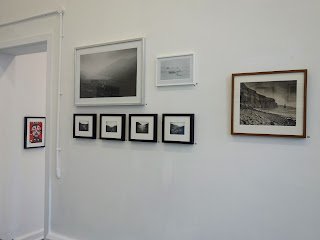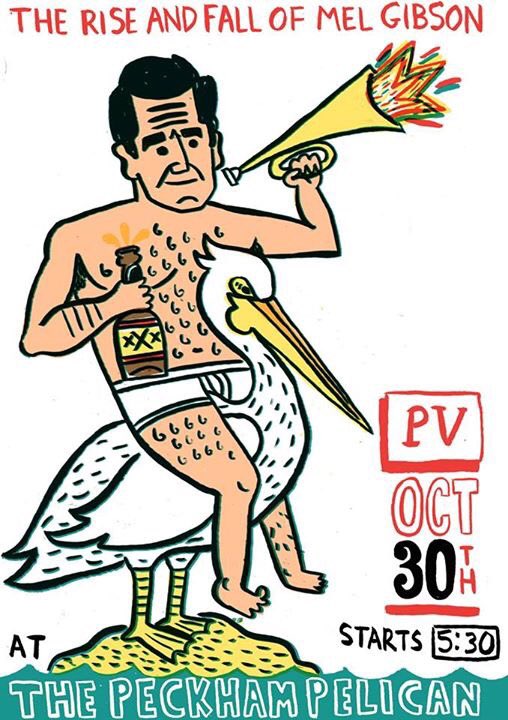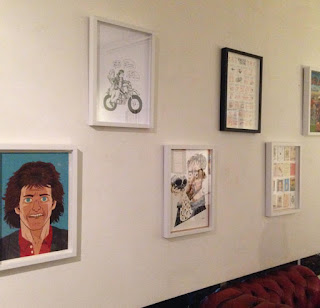The late shift at the
Hamburger Bahnhof, a contemporary art museum in Berlin, which I visited last week. Money is being counted, the guards are rubbing their eyes, and I have the daunting task of seeing all the collections and temporary exhibitions in just half an hour.
In the museum's Historical Hall, Berlin based Scottish artist
Susan Philipsz has drawn on the former function of the museum building as a train terminus to create a sound installation "Part File Score" about the Austrian composer Hanns Eisler and his "moved life". Alongside his close friend Brecht, Eisler's music was banned by the Nazis in the 1930s and Eisler was forced into exile, finally getting a visa to the USA in 1938. He was deported from the US in 1948 accused of being a Communist agent. The artist has placed overlaid documents about Eisler by the FBI over his musical scores on the walls, and loudspeakers on the 24 pillars play single notes in succession from Eisler's film compositions. You don't know from which direction the next note will come. It disorients, surprises, and the fact that space is so big and empty makes you question your position.
It is interesting that Eisler's political beliefs informed his musical direction and that he consciously moved away from the twelve tone technique he had learned as a disciple of Schönberg to write more popular film and theatre music, which he saw as more fitting to his socialist political beliefs. On his return to Germany, he also composed the
GDR national anthem. He was accused, however, of plagiarism as the first four lines are similar to a popular song
"Goodbye Johnny" written by another Austrian composer, Peter Keuder, for a German film from 1939, "Wasser für Canitoga".
In this
popular song the protagonist is saying goodbye to his best friend, a soldier who has fallen at his side in the war. When the main refrain of this song begins the singer switches from German into English, "cheerio, cheerio cheerio". Through its repetition and rhythm, it is reminiscent of a train starting up or a whistle blowing before departure before rolling into the chorus with "Goodbye Johnny, Goodbye Johnny..."The lyrics include (in German) "I have to carry on. Always moving forward. Following my fate, my luck". The singer is dreaming of a "reunion" with his lost comrade in "heaven or hell" (he doesn't know which), and dreams that "in a hundred years everything will be over".
The themes of separation and unification are also heavily present in the lyrics of the GDR anthem by
poet Johannes R Becher ,which Eisler wrote the music for. There is no "hell" but a kind a type of heavenly utopia with people uniting in a new Germany of the future where "Triumph over bygone sorrow can in unity be won, for we shall attain a morrow when over Germany there is radiant sun". Apparently Eisler wrote the music for the
GDR national anthem on the train journey from Austria to Germany after his return from the USA. Perhaps he was also thinking of his personal "cheerios" or maybe he was thinking optimistically about his new future in Germany, his reverie thriving in the space between departure and arrival.
In the exhibit, the overlayed images of Eisler's musical manuscripts with bureaucratic documents contain two forms of language: musical notation, which is incomprehensible for those who cannot read music, and bureaucratic notes, full of errors in part and equally incomprehensible as a means to judge and quantify a life. In addition, swathes of black ink censors information and erases pencilled notation and staves. Standing in the Historic Hall, the work brings to mind the German phrase "nur Bahnhof verstehen" which in its literal sense means "only understand train station" but commonly means "you cannot follow or understand what is being said".
According to
Wikionary this phrase has its origins in the first world war, in which Hanns Eisler was a soldier:
The soldiers apparently were tired of fighting and wanted to return home. Since the primary means of transportation was by train, many soldiers associated the train station (Bahnhof) with returning home. As the soldiers were preoccupied with returning home it could happen that they could or would not follow the conversation because they "only understood train station".
It also adds that the phrase can also mean when someone doesn't
want to understand what they are hearing, they ignore it by saying the phrase in part to annoy the other person.
A play on words by the author "Hans Fallada" from the book "Wer einmal aus dem Blechnapf frisst" has a dialogue between two people also using the phrase:
"I only understand train station", he says.
"Train station isn't so bad when you need to make a getaway" she replies, subverting it back to its actual meaning.
In art galleries and museums I often feel the visitor is being tested about how much they understand the art or whether they "only understand train station". In this exhibit and in this particularly accessible contemporary art museum the latter is perfectly fine.






















































